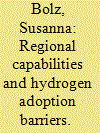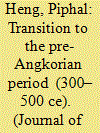| Srl | Item |
| 1 |
ID:
130648


|
|
|
|
|
| Publication |
2013.
|
| Summary/Abstract |
The committee's report has highlighted the diversity of the countries of the Indian Ocean Rim and the multiple ways it which these states can be categorised. This diversity and the lack of a single agreed definition of the 'Indian Ocean Rim' has created a significant challenge for the development of policy, from both an Australian and a regional perspective. Australia's approach to trade in the Indian Ocean Rim is largely bilateral; defence and strategic relations are based on single issue groupings; and aid to the region is predominately provided under the auspices of the United Nations. Evidence gathered in relation to the Indian Ocean Rim Association for Regional Co-operation (IOR-ARC) demonstrates clearly that diversity in the region - both economic and political - has created inertia in the region's main organisation.
|
|
|
|
|
|
|
|
|
|
|
|
|
|
|
|
| 2 |
ID:
193754


|
|
|
|
|
| Summary/Abstract |
Hydrogen is gaining importance to decarbonize the energy system and tackle the climate crisis. This exploratory study analyzes three focus groups with representatives from relevant organizations in a Northern German region that has unique beneficial characteristics for the transition to a hydrogen economy. Based upon this data, (1) a category system of innovation adoption barriers for hydrogen technologies is developed, (2) decision levels associated with the barriers are identified, (3) detailed insights on how decision levels contribute to the adoption barriers are provided and (4) the barriers are evaluated in terms of their importance. Our analysis adds to existing literature by focusing on short-term barriers and exploring relevant decision levels and their associated adoption barriers. Our main results comprise the following: flaws in the funding system, complex approval procedures, lack of networks and high costs contribute to hydrogen adoption barriers. The (Sub-)State level is relevant for the uptake of the hydrogen economy. Regional entities have leeway to foster the hydrogen transition, especially with respect to the distribution infrastructure. Funding policy, technological suitability, investment and operating costs, and the availability of distribution infrastructure and technical components are highly important adoption barriers that alone can impede the transition to a hydrogen economy.
|
|
|
|
|
|
|
|
|
|
|
|
|
|
|
|
| 3 |
ID:
147671


|
|
|
|
|
| Summary/Abstract |
Archaeological data over the past two decades have contributed to our understanding of the transition into the historic period in Southeast Asia and rebutted outdated models of externally stimulated complex polity formation. This article investigates the transition into the Pre-Angkorian period 300–500 CE based on a model constructed using archaeological data from Thala Borivat, Cambodia. Data from Thala Borivat suggest a pattern of continuity where smaller proto-historic settlements may have become incorporated c.300–500 CE into larger ones which became major Pre-Angkorian centres. This phenomenon coincided with evidence of increasing inter- and intra-regional interaction following the proto-historic period. This article argues that the model can be used to reinterpret the pattern observed in major Pre-Angkorian centres in the Mekong Delta and northeast Thailand. This pattern is complemented by the spatial correlation between the chronometrically-anchored ceramic traditions in proto-historic and early historic period Cambodia that suggests the continuity of local communities. Spatial correlation between prehistoric sites and inscriptions recording Pre-Angkorian elites, particularly the poñ, mratāñ, and kings provides similar patterns of continuity between the elites of the late proto-historic to the Pre-Angkorian periods.
|
|
|
|
|
|
|
|
|
|
|
|
|
|
|
|